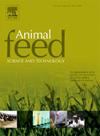Effect of dietary carbohydrate sources on growth performance and carbohydrate utilisation in abalone, Haliotis discus hannai Ino
IF 2.5
2区 农林科学
Q1 AGRICULTURE, DAIRY & ANIMAL SCIENCE
引用次数: 0
Abstract
Despite the importance of carbohydrates in the natural diet of abalone, there is little information about the specific effects of commonly available dietary sources. Therefore, this experiment was conducted to determine the effects of several carbohydrate sources, using a semi-purified base diet containing casein and gelatine, on the growth performance metrics and metabolic response of abalone, Haliotis discus hannai Ino. Six experimental diets were formulated containing 33.50 % of different carbohydrate sources including dextrin, pregelatinized wheat starch, wheat starch, tapioca starch, potato starch and corn starch. The diets were fed to the abalone with an initial weight of 3.42 ± 0.02 g in triplicate tanks for 24 weeks, housed in a recirculation system, with seawater maintained at 18–20 ℃. There were no significant differences detected in the average daily increment in shell length (DISL, μm/day) or survival of abalone fed the six treatments containing different carbohydrate sources. However, there were significant differences detected in the average final weight and weight gain rate (WGR, %) parameters, with the lowest final weight (8.16 ± 0.29 g) and WGR (140.38 ± 6.57 %) observed in the potato starch fed abalone.While the potato starch group had the ssignificant highest valuein the moisture content (79.31 ± 0.07 %), crude protein (75.37 ± 0.37 %) and crude ash (10.52 ± 0.20 %) present in the soft-tissue and similarly in the crude ash level (96.06 ± 0.29 %) in the shell composition among the six dietary treatments. There was no significant difference found in the soft-tissue lipid content (5.84–6.87 %). The dextrin-based diet led to elevated plasma glucose (0.85 ± 0.06 mmol/l) in abalone compared with the other treatment groups. The concentration of muscle glycogen in abalone fed with pregelatinized wheat starch showed the highest values with 78.45 ± 1.53 mg/g tissue, which was significantly different to the other treatment groups, however, the digestive gland glycogen content (15.56–19.27 mg/g tissue) was maintained at a constant level regardless of the dietary carbohydrate sources. The digestive gland α-amylase activity in abalone was significantly higher in the pregelatinized wheat starch fed abalone (211.65 ± 16.16 mg starch/30 min/g protein) compared to the dextrin (93.58 ± 13.40 mg starch/30 min/g protein) and potato (99.37 ± 11.15 mg starch/30 min/g protein) starch fed abalones. The results presented demonstrate that abalone efficiently utilized the carbohydrate sources evaluated in the present study, the dextrin and pregelatinized wheat starch were the most suitable sources based on the growth performance alone. There were discrete metabolic and enzymatic responses observed among the dietary groups, like the interrupting the normal glucose metabolic processes by the potato starch,which may lead to improved dietary formulations.
日粮碳水化合物来源对鲍鱼(Haliotis discus hannai Ino)生长性能和碳水化合物利用率的影响
尽管碳水化合物在鲍鱼的天然食物中非常重要,但有关常见食物来源的具体影响的信息却很少。因此,本实验使用含有酪蛋白和明胶的半纯化基础日粮,测定几种碳水化合物来源对鲍鱼(Haliotis discus hannai Ino)生长性能指标和代谢反应的影响。六种实验日粮含有 33.50%的不同碳水化合物来源,包括糊精、预胶化小麦淀粉、小麦淀粉、木薯淀粉、马铃薯淀粉和玉米淀粉。鲍鱼的初始体重为 3.42 ± 0.02 克,在一式三份的饲养箱中饲养 24 周,饲养箱采用循环系统,海水温度保持在 18-20 ℃。在含有不同碳水化合物来源的六种处理中,鲍鱼的壳长平均日增量(DISL,μm/天)和存活率没有发现明显差异。然而,在平均最终重量和增重率(WGR,%)参数上却发现了明显的差异,马铃薯淀粉喂养的鲍鱼的最终重量(8.16 ± 0.29 克)和增重率(140.38 ± 6.57%)最低。在六种日粮处理中,马铃薯淀粉组的软组织水分含量(79.31 ± 0.07 %)、粗蛋白(75.37 ± 0.37 %)和粗灰分(10.52 ± 0.20 %)显著最高,壳的粗灰分含量(96.06 ± 0.29 %)也同样最高。软组织脂质含量(5.84-6.87%)没有明显差异。与其他处理组相比,以糊精为基础的日粮导致鲍鱼血浆葡萄糖升高(0.85 ± 0.06 mmol/l)。用预胶化小麦淀粉饲喂的鲍鱼肌肉糖原浓度最高,为 78.45 ± 1.53 毫克/克组织,与其他处理组相比有显著差异,但消化腺糖原含量(15.56-19.27 毫克/克组织)保持稳定,与日粮碳水化合物来源无关。与糊精(93.58 ± 13.40 毫克淀粉/30 分钟/克蛋白质)和马铃薯(99.37 ± 11.15 毫克淀粉/30 分钟/克蛋白质)淀粉饲喂的鲍鱼相比,预糊化小麦淀粉饲喂的鲍鱼消化腺α-淀粉酶活性(211.65 ± 16.16 毫克淀粉/30 分钟/克蛋白质)明显更高。研究结果表明,鲍鱼能有效利用本研究中评估的碳水化合物来源,仅从生长表现来看,糊精和预胶化小麦淀粉是最合适的碳水化合物来源。在各组日粮中观察到了不同的代谢和酶反应,如马铃薯淀粉干扰了正常的葡萄糖代谢过程,这可能会导致日粮配方的改进。
本文章由计算机程序翻译,如有差异,请以英文原文为准。
求助全文
约1分钟内获得全文
求助全文
来源期刊

Animal Feed Science and Technology
农林科学-奶制品与动物科学
CiteScore
6.00
自引率
6.20%
发文量
266
审稿时长
3 months
期刊介绍:
Animal Feed Science and Technology is a unique journal publishing scientific papers of international interest focusing on animal feeds and their feeding.
Papers describing research on feed for ruminants and non-ruminants, including poultry, horses, companion animals and aquatic animals, are welcome.
The journal covers the following areas:
Nutritive value of feeds (e.g., assessment, improvement)
Methods of conserving and processing feeds that affect their nutritional value
Agronomic and climatic factors influencing the nutritive value of feeds
Utilization of feeds and the improvement of such
Metabolic, production, reproduction and health responses, as well as potential environmental impacts, of diet inputs and feed technologies (e.g., feeds, feed additives, feed components, mycotoxins)
Mathematical models relating directly to animal-feed interactions
Analytical and experimental methods for feed evaluation
Environmental impacts of feed technologies in animal production.
 求助内容:
求助内容: 应助结果提醒方式:
应助结果提醒方式:


